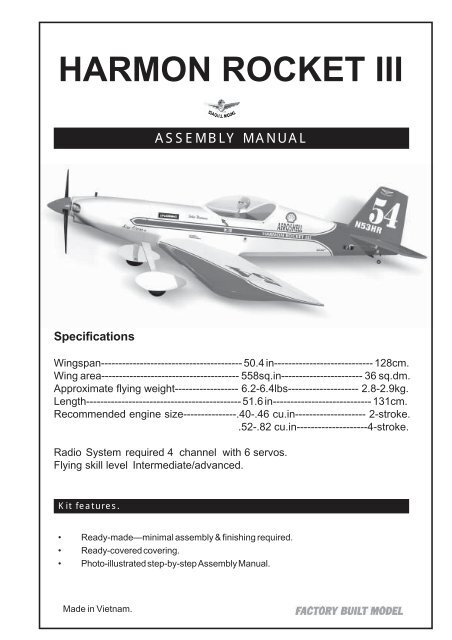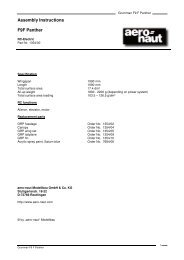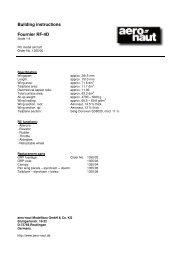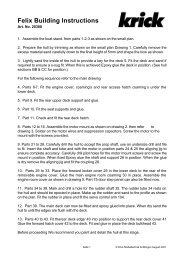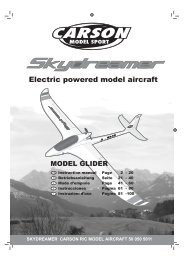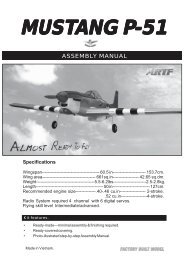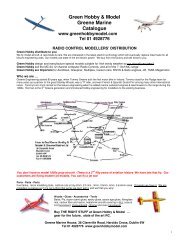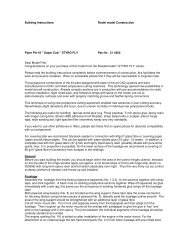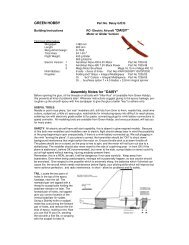HARMON ROCKET III - Green Hobby & Model
HARMON ROCKET III - Green Hobby & Model
HARMON ROCKET III - Green Hobby & Model
You also want an ePaper? Increase the reach of your titles
YUMPU automatically turns print PDFs into web optimized ePapers that Google loves.
<strong>HARMON</strong> <strong>ROCKET</strong> <strong>III</strong><br />
Hand-made Almost Ready to Fly R/C <strong>Model</strong> Aircraft<br />
ASSEMBLY MANUAL<br />
Specifications<br />
Wingspan---------------------------------------- 50.4 in---------------------------- 128cm.<br />
Wing area--------------------------------------- 558sq.in----------------------- 36 sq.dm.<br />
Approximate flying weight------------------ 6.2-6.4lbs-------------------- 2.8-2.9kg.<br />
Length-------------------------------------------- 51.6 in---------------------------- 131cm.<br />
Recommended engine size---------------.40-.46 cu.in-------------------- 2-stroke.<br />
.52-.82 cu.in--------------------4-stroke.<br />
Radio System required 4 channel with 6 servos.<br />
Flying skill level Intermediate/advanced.<br />
Kit features.<br />
• Ready-made—minimal assembly & finishing required.<br />
• Ready-covered covering.<br />
• Photo-illustrated step-by-step Assembly Manual.<br />
Made in Vietnam.
<strong>HARMON</strong> <strong>ROCKET</strong> <strong>III</strong>. Instruction Manual.<br />
INTRODUCTION.<br />
Thank you for choosing the Harmon Rocket <strong>III</strong> ARTF by SEAGULL MODELS. The Harmon Rocket<br />
<strong>III</strong> was designed with the intermediate/advanced sport flyer in mind. It is a semi scale airplane which<br />
is easy to fly and quick to assemble. The airframe is conventionally built using balsa, plywood to<br />
make it stronger than the average ARTF , yet the design allows the aeroplane to be kept light. You<br />
will find that most of the work has been done for you already.Flying the Harmon Rocket <strong>III</strong> is simply<br />
a joy.<br />
This instruction manual is designed to help you build a great flying aeroplane. Please read this<br />
manual thoroughly before starting assembly of your Harmon Rocket <strong>III</strong>. Use the parts listing below<br />
to identify all parts.<br />
WARNING.<br />
Please be aware that this aeroplane is not a toy and if assembled or used incorrectly it is<br />
capable of causing injury to people or property. WHEN YOU FLY THIS AEROPLANE YOU<br />
ASSUME ALL RISK & RESPONSIBILITY.<br />
If you are inexperienced with basic R/C flight we strongly recommend you contact your R/C supplier<br />
and join your local R/C <strong>Model</strong> Flying Club. R/C <strong>Model</strong> Flying Clubs offer a variety of training<br />
procedures designed to help the new pilot on his way to successful R/C flight. They will also be able<br />
to advise on any insurance and safety regulations that may apply.<br />
ADDITIONAL ITEMS REQUIRED.<br />
! .40-.46 2-stroke engine<br />
.52-.82 4-stroke engine<br />
! Computer radio with six servos<br />
! Glow plug to suit engine<br />
! Propeller to suit engine<br />
! Protective foam rubber for radio<br />
system<br />
! Silicone fuel line<br />
TOOLS & SUPPLIES NEEDED.<br />
! Thick cyanoacrylate glue<br />
! 30 minute epoxy<br />
! 5 minute epoxy<br />
! Hand or electric drill<br />
! Assorted drill bits<br />
! <strong>Model</strong>ling knife<br />
! Straight edge ruler<br />
! 2mm ball driver<br />
! Phillips head screwdriver<br />
! 220 grit sandpaper<br />
! 90° square or builder’s triangle<br />
! Wire cutters<br />
! Masking tape & T-pins<br />
! Thread-lock<br />
! Paper towels<br />
PARTS LISTING.<br />
FUSELAGE ASSEMBLY<br />
! (1) Fuselage<br />
! (1) Canopy hatch<br />
WING ASSEMBLY<br />
! (1) Right wing half with pre-installed<br />
aileron<br />
! (1) Left wing half with pre-installed<br />
aileron<br />
! (1) Aluminium dihedral brace<br />
Tail section assembly<br />
! (1) Horizontal stabilizer with preinstalled<br />
elevator halves<br />
Some more parts.<br />
HARDWARE PACK<br />
COWLING<br />
Landing gear.....<br />
2
<strong>HARMON</strong> <strong>ROCKET</strong> <strong>III</strong>. Instruction Manual.<br />
NOTE: To avoid scratching your new aeroplane<br />
we suggest that you cover your<br />
workbench with an old towel. Keep a<br />
couple of jars or bowls handy to hold<br />
the small parts after you open the<br />
bags.<br />
Please trial fit all parts. Make sure you<br />
have the correct parts and that they<br />
fit and are aligned properly before<br />
gluing! This will ensure proper assembly<br />
as the Harmon Rocket <strong>III</strong> is<br />
made from natural materials and<br />
minor adjustments may have to be<br />
made.<br />
The paint and plastic parts used in<br />
this kit are fuel proof. However, they<br />
are not tolerant of many harsh chemicals<br />
including the following: paint<br />
thinner, cyano-acrylate glue accelerator,<br />
cyanoacrylate glue de-bonder<br />
and acetone. Do not let these chemicals<br />
come in contact with the colours<br />
on the covering and the plastic parts.<br />
3
<strong>HARMON</strong> <strong>ROCKET</strong> <strong>III</strong>. Instruction Manual.<br />
HINGING THE AILERONS.<br />
Note: The control surfaces, including the<br />
ailerons, elevators, and rudder, are<br />
prehinged with hinges installed, but the<br />
hinges are not glued in place. It is<br />
imperative that you properly adhere the<br />
hinges in place per the steps that follow<br />
using a high-quality thin C/A glue.<br />
! 1) Carefully remove the aileron from one<br />
of the wing panels. Note the position of the<br />
hinges.<br />
! 4)Deflect the aileron and completely<br />
saturate each hinge with thin C/A glue. The<br />
ailerons front surface should lightly contact the<br />
wing during this procedure. Ideally, when the<br />
hinges are glued in place, a 1/64” gap or less<br />
will be maintained throughout the lengh of the<br />
aileron to the wing panel hinge line.<br />
Note:<br />
The hinge is constructed of a special<br />
material that allows the C/A to wick or<br />
penetrate and distribute throughout the<br />
hinge, securely bonding it to the wood<br />
structure of the wing panel and aileron.<br />
! 2) Remove each hinge from the wing panel<br />
and aileron and place a T-pin in the center of<br />
each hinge. Slide each hinge into the aileron<br />
until the T-pin is snug against the aileron. This<br />
will help ensure an equal amount of hinge is<br />
on either side of the hinge line when the aileron<br />
is mounted to the wing panel.<br />
C/A glue.<br />
T-pin.<br />
! 3) Slide the aileron on the wing panel until<br />
there is only a slight gap. The hinge is now<br />
centered on the wing panel and aileron.<br />
Remove the T-pins and snug the aileron<br />
against the wing panel. A gap of 1/64” or less<br />
should be maintained between the wing panel<br />
and aileron.<br />
! 5) Turn the wing panel over and deflect the<br />
aileron in the opposite direction from the<br />
opposite side. Apply thin C/A glue to each<br />
hinge, making sure that the C/A penetrates into<br />
both the aileron and wing panel.<br />
C/A glue.<br />
T-pin.<br />
! 6) Using C/A remover/debonder and a<br />
paper towel, remove any excess C/A glue that<br />
may have accumulated on the wing or in the<br />
aileron hinge area.<br />
! 7) Repeat this process with the other wing<br />
panel, securely hinging the aileron in place.<br />
4
<strong>HARMON</strong> <strong>ROCKET</strong> <strong>III</strong>. Instruction Manual.<br />
! 8) After both ailerons are securely hinged,<br />
firmly grasp the wing panel and aileron to<br />
make sure the hinges are securely glued and<br />
cannot be pulled out. Do this by carefully<br />
applying medium pressure, trying to separate<br />
the aileron from the wing panel. Use caution<br />
not to crush the wing structure.<br />
Note: Work the aileron up and down several<br />
times to “work in” the hinges and check<br />
for proper movement.<br />
HINGING THE ELEVATORS.<br />
! 4)Deflect the elevator and completely<br />
saturate each hinge with thin C/A glue. The<br />
elevators front surface should lightly contact<br />
the horizontal stabilizer during this procedure.<br />
Ideally, when the hinges are glued in place, a<br />
1/64” gap or less will be maintained throughout<br />
the lengh of the elevator to the horizontal<br />
stabilizer panel hinge line.<br />
Note: The hinge is constructed of a special<br />
material that allows the C/A to wick or<br />
penetrate and distribute throughout the<br />
hinge, securely bonding it to the wood<br />
structure of the horizontal stabilizer<br />
panel and elevator.<br />
! 1) Carefully remove the elevator from one<br />
of the horizontal stabilizer panels. Note the<br />
position of the hinges.<br />
! 2) Remove each hinge from the horizontal<br />
stabilizer panel and elevator and place a T-pin<br />
in the center of each hinge. Slide each hinge<br />
into the elevator until the T-pin is snug against<br />
the elevator. This will help ensure an equal<br />
amount of hinge is on either side of the hinge<br />
line when the elevator is mounted to the<br />
horizontal stabilizer panel.<br />
C/A glue.<br />
! 5) Turn the horizontal stabilizer panel over<br />
and deflect the elevator in the opposite<br />
direction from the opposite side. Apply thin CA<br />
glue to each hinge, making sure that the C/A<br />
penetrates into both the elevator and horizontal<br />
stabilizer panel.<br />
! 3) Slide the elevator on the horizontal<br />
stabilizer panel until there is only a slight gap.<br />
The hinge is now centered on the horizontal<br />
stabilizer panel and elevator. Remove the T-<br />
pins and snug the elevator against the<br />
horizontal stabilizer panel. A gap of 1/64” or<br />
less should be maintained between the<br />
horizontal stabilizer panel and elevator.<br />
! 6) Using C/A remover/debonder and a<br />
paper towel, remove any excess C/A glue that<br />
may have accumulated on the horizontal<br />
stabilizer or in the elevator hinge area.<br />
! 7) Repeat this process with the other<br />
horizontal stabilizer panel, securely hinging the<br />
elevator in place.<br />
! 8) After both elevator are securely hinged,<br />
firmly grasp the horizontal stabilizer panel and<br />
elevator to make sure the hinges are securely<br />
glued and cannot be pulled out. Do this by<br />
carefully applying medium pressure, trying to<br />
separate the elevator from the horizontal<br />
stabilizer panel. Use caution not to crush the<br />
horizontal stabilizer structure.<br />
5
<strong>HARMON</strong> <strong>ROCKET</strong> <strong>III</strong>. Instruction Manual.<br />
HINGING THE RUDDER.<br />
! 1) Carefully remove the rudder from one of<br />
the fuselage panel. Note the position of the<br />
hinges.<br />
! 2) Remove each hinge from the fuselage<br />
panel and rudder and place a T-pin in the center<br />
of each hinge. Slide each hinge into the rudder<br />
until the T-pin is snug against the rudder. This<br />
will help ensure an equal amount of hinge is<br />
on either side of the hinge line when the rudder<br />
is mounted to the fuselage panel.<br />
Note: The hinge is constructed of a special<br />
material that allows the C/A to wick or penetrate<br />
and distribute throughout the hinge, securely<br />
bonding it to the wood structure of the fuselage<br />
panel and rudder.<br />
C/A glue.<br />
Hinge.<br />
! 3) Slide the rudder on the fuselage panel<br />
until there is only a slight gap. The hinge is<br />
now centered on the fuselage panel and rudder.<br />
Remove the T-pins and snug the rudder<br />
against the fuselage panel. A gap of 1/64” or<br />
less should be maintained between the<br />
fuselage panel and rudder.<br />
C/A glue.<br />
Hinge.<br />
! 5) Turn the fuselage panel over and deflect<br />
the rudder in the opposite direction from the<br />
opposite side. Apply thin C/A glue to each<br />
hinge, making sure that the C/A penetrates into<br />
the rudder and fuselage panel.<br />
! 4)Deflect the rudder and completely<br />
saturate each hinge with thin C/A glue. The<br />
rudder front surface should lightly contact the<br />
fuselage during this procedure. Ideally, when<br />
the hinges are glued in place, a 1/64” gap or<br />
less will be maintained throughout the lengh<br />
of the rudder to the fuselage panel hinge line.<br />
! 6) Using C/A remover/debonder and a<br />
paper towel, remove any excess C/A glue that<br />
may have accumulated on the fuselage or in<br />
the rudder hinge area.<br />
Note: Work the rudder left and right several<br />
times to “work in” the hinges and check<br />
for proper movement.<br />
6
<strong>HARMON</strong> <strong>ROCKET</strong> <strong>III</strong>. Instruction Manual.<br />
WING ASSEMBLY.<br />
NOTE:We highly recommend using 30<br />
minute epoxy as it is stronger and<br />
provides more working time, allowing<br />
the builder to properly align the parts.<br />
Using fast cure epoxy when joining<br />
the wing halves could result in the<br />
glue drying before the wing halves are<br />
aligned properly which may result in<br />
failure of the wing centre section<br />
during flight.<br />
! 1) Locate the plywood wing dihedral brace.<br />
Using a ruler, locate its centre and draw a<br />
vertical line .<br />
Centre line.<br />
Carefully slide the two wing halves together<br />
and firmly press them together, allowing the<br />
excess epoxy to run out. There should not be<br />
any gap in the wing halves. Use rubbing<br />
alcohol and a paper tower to clean up any<br />
excess epoxy.<br />
! 2) Test fit the dihedral brace into each wing<br />
half. The brace should slide in easily up to the<br />
centreline that you drew. If not, use 220 grit<br />
sandpaper with a sanding block and sand<br />
down the edges and ends of the brace until it<br />
fits properly.<br />
Apply masking tape at the wing join to hold the<br />
wing halves together securely.<br />
Masking tape.<br />
! 3) Remove the brace when satisfied with<br />
its fit in each wing half. Coat both sides of one<br />
half of the dihedral brace with 30 minute epoxy.<br />
Next, pour some epoxy into the dihedral box in<br />
one wing panel. Make sure you cover the top<br />
and bottom as well as the sides of the dihedral<br />
brace. Use enough epoxy to fill any gaps.<br />
! 4) Peel off the backing from the self adhesive<br />
covering strip. Apply the strip to the centre<br />
section of the wing starting from the bottom<br />
trailing edge. Wrap the strip all the way around<br />
the wing until it meets the trailing edge again.<br />
Trim off any excess strip.<br />
Expoxy.<br />
7
<strong>HARMON</strong> <strong>ROCKET</strong> <strong>III</strong>. Instruction Manual.<br />
Remove covering.<br />
Using a small weight (Weighted fuel pick-up<br />
works well) and thread, feed the string through<br />
the wing as indicated.<br />
Glue attached.<br />
INSTALLING THE AILERON SERVOS.<br />
Small weight.<br />
Thread.<br />
Servo.<br />
Thread.<br />
We recommended to use long servos<br />
arm for all servos without throttle<br />
servo.<br />
Install the rubber grommets and brass<br />
collets onto the aileron servo. Test fit the servo<br />
into the aileron servo mount.<br />
Install the servo into the servo tray.<br />
Because the size of servos differ,<br />
you may need to adjust the size of the<br />
precut opening in the mount. The notch<br />
in the sides of the mount allow the servo<br />
lead to pass through.<br />
Wing bottom.<br />
Small weight.<br />
Attach servo lead to the aileron servo. Attach<br />
the string to the servo lead and carefully thread<br />
it though the wing. Once you have thread the<br />
lead throught the wing, remove the string so it<br />
can use for the other servo lead. Tape the servo<br />
lead to the wing to prevent it from falling back<br />
into the wing.<br />
8
<strong>HARMON</strong> <strong>ROCKET</strong> <strong>III</strong>. Instruction Manual.<br />
Thread.<br />
Thread.<br />
Plastic tape.<br />
AILERON LINKAGE.<br />
INSTALLING THE AILERON LINKAGE.<br />
! 1) Using a ruler & pen to draw a straight<br />
line as below picture.<br />
Straight line.<br />
Install the aileron servo tray into the servo<br />
mount.<br />
Repeat the procedure for orther wing<br />
haft.<br />
Pen.<br />
Thread.<br />
Servo arm.<br />
Small weight.<br />
9
<strong>HARMON</strong> <strong>ROCKET</strong> <strong>III</strong>. Instruction Manual.<br />
! 2) Locate the two nylon control horns,<br />
two nylon control horn backplates and two<br />
machine screws.<br />
Aileron pushrod rod.<br />
Pen.<br />
2MM x 30 MM.<br />
Clevis.<br />
! 3) Position the aileron horn on the bottom<br />
side of aileron. The clevis attachment holes<br />
should be positioned over the hinge line.<br />
Control Horn.<br />
Cut.<br />
Mounting Screws.<br />
Mounting Plate.<br />
M2 clevis.<br />
! 4) Using a 1mm drill bit and the control<br />
horns as a guide, drill the mounting holes<br />
through the aileron halves.<br />
M2 lock nut.<br />
Snap keepper.<br />
! 5) Mount the control horns by inserting<br />
the screws through the control horn bases and<br />
aileron halves, then into the mounting<br />
backplates. Do not overtighten the screws or<br />
the backplates may crush the wood.<br />
! 6) Thread one nylon adjustable control<br />
horn onto each aileron control rod. Thread the<br />
horns on until they are flush with the ends of<br />
the control rods. Repeat the procedure for the other<br />
aileron servo.<br />
10
<strong>HARMON</strong> <strong>ROCKET</strong> <strong>III</strong>. Instruction Manual.<br />
See pictures below:<br />
ENGINE MOUNT.<br />
! 2) Using a modeling knife, cut one length<br />
of silicon fuel line . Connect one end of the<br />
line to the weighted fuel pickup and the other<br />
end to the nylon pickup tube.<br />
! 3) Carefully bend the second nylon tube<br />
up at a 45º angle. This tube is the vent tube.<br />
M4.<br />
Important: When the stopper assembly is<br />
installed in the tank, the top of the vent tube<br />
should rest just below the top surface of the<br />
tank. It should not touch the top of the tank.<br />
FUEL TANK.<br />
Silicon tubing not inclued.<br />
! 4) Carefully heat the vent tube using a<br />
heat gun or lighter to permanently set the<br />
angle of the tube.<br />
Vent tube.<br />
Fuel Pickup<br />
Tube.<br />
Fuel Fill Tube.<br />
INSTALLING THE STOPPER ASSEMBLY.<br />
! 1) Using a modeling knife, carefully cut<br />
off the rear portion of one of the two nylon tubes<br />
leaving 1/2” protruding from the rear of the<br />
stopper. This will be the fuel pick up tube.<br />
When the stopper assembly is installed in the<br />
tank, the top of the vent tube should rest just<br />
below the top surface of the tank. It should<br />
not touch the top of the tank.<br />
! 5) Test fit the stopper assembly into the<br />
tank. It may be necessary to remove some of<br />
11
<strong>HARMON</strong> <strong>ROCKET</strong> <strong>III</strong>. Instruction Manual.<br />
the flashing around the tank opening using a<br />
modeling knife. If flashing is present, make<br />
sure none falls into the tank.<br />
! 6) With the stopper assembly in place,<br />
the weighted pickup should rest about 3/8”<br />
away from the rear of the tank and move freely<br />
inside the tank. The top of the vent tube should<br />
rest just below the top of the tank. It should<br />
not touch the top of the tank.<br />
Fuel pickup<br />
tube.<br />
Vent tube.<br />
Fuel fill tube.<br />
! 7) When satisfied with the alignment of<br />
the stopper assembly tighten the 3mm x 20mm<br />
machine screw until the rubber stopper expands<br />
and seals the tank opening. Do not<br />
overtighten the assembly as this could cause<br />
the tank to split.<br />
Blow through one of the lines to ensure<br />
the fuel lines have not become kinked inside<br />
the fuel tank compartment. Air should flow<br />
through easily.<br />
MOUNTING THE ENGINE.<br />
PARTS REQUIRED<br />
! 1) Install the pushrod housing through the<br />
predrilled hole in the firewall and into the servo<br />
compartment. The pushrod housing should<br />
protrude 1/4" out past the front of the firewall.<br />
Make a Z-Bend 1/4" from one end of the plain<br />
wire pushrod.<br />
You should mark which tube is the vent<br />
and which is the fuel pickup when you<br />
attach fuel tubing to the tubes in the stopper.<br />
Once the tank is installed inside the fuselage,<br />
it may be difficult to determine which is which.<br />
EVOLUTION<br />
Engine .46.<br />
Slide the tank into the fuselage from inside so<br />
that the neck is at the top of the fuselage and<br />
it locates through the engine bulkhead. Gently<br />
secure it to the top horizontal former with a<br />
cable tie.<br />
Fuel tank.<br />
11.3cm.<br />
! 2) Place your engine onto the engine<br />
mount. Adjust the engine is centered of the<br />
edges of the engine case.<br />
! 3) When you are satisfied with the alignment,<br />
mark the locations of the engine<br />
mounting.<br />
! 4) Remove the engine. Using an drill bit,<br />
drill the mounting holes through the engine<br />
mount at the four locations marked.<br />
12
<strong>HARMON</strong> <strong>ROCKET</strong> <strong>III</strong>. Instruction Manual.<br />
4.2- 4.5mm.<br />
COWLING.<br />
4mm X 30mm.<br />
! 1) Slide the fiberglass cowl over the engine<br />
and line up the back edge of the cowl with<br />
the marks you made on the fuselage then trim<br />
and cut.<br />
Trim and cut.<br />
! 5) Bolt the engine to the engine mount<br />
using the four machine screws and lock<br />
washer. Double cheek that all the screws are<br />
tight before proceeding.<br />
Trim and cut.<br />
! 6) Attach the Z-Bend in the pushrod wire<br />
to the throttle arm on the carburetor. You will<br />
need to remove the throttle arm from the carburetor<br />
to be able to attach the Z-bend. When<br />
complete, reattach the throttle arm to the carburetor.<br />
Trim and cut.<br />
!2) While keeping the back edge of the cowl<br />
flush with the marks, align the front of the cowl<br />
with the crankshaft of the engine. The front of<br />
the cowl should be positioned so the crankshaft<br />
is in nearly the middle of the cowl opening.<br />
Use the spinner backplate as a guide. Hold<br />
the cowl firmly in place using pieces of masking<br />
tape.<br />
Pushrod wire.<br />
Because of the diameter of the cowl, it<br />
may be necessary to use a needle valve extension<br />
for the high speed needle valve. Make<br />
this out of sufficient length 1.5mm wire and<br />
install it into the end of the needle valve. Secure<br />
the wire in place by tightening the set<br />
screw in the side of the needle valve.<br />
13
<strong>HARMON</strong> <strong>ROCKET</strong> <strong>III</strong>. Instruction Manual.<br />
1.5mm wire<br />
(needle valve).<br />
! 3) Slide the cowl back over the engine<br />
and secure it in place using four 3mm x 12mm<br />
wood screws. See picture below.<br />
! 4) Install the muffler and muffler extension<br />
onto the engine and make the cutout in the<br />
cowl for muffler clearance. Connect the fuel<br />
and pressure lines to the carburetor, muffler<br />
and fuel filler valve.<br />
INSTALLING THE SPINNER.<br />
!1) Install the spinner backplate, propeller and<br />
spinner cone. The spinner cone is held in<br />
place using two 3mm x 12mm wood screws.<br />
The propeller should not touch any part<br />
of the spinner cone. If it does, use a<br />
sharp modeling knife and carefully trim away<br />
the spinner cone where the propeller comes<br />
in contact with it.<br />
Machine screw<br />
3mm X 12mm.<br />
14
<strong>HARMON</strong> <strong>ROCKET</strong> <strong>III</strong>. Instruction Manual.<br />
WHEEL AND WHEEL PANTS.<br />
PARTS REQUIRED<br />
(2) Wheel Collar.<br />
(2) Washer.<br />
! 1) Assembling and mounting the wheel<br />
pants as shown below pictures.<br />
Axle.<br />
Wheel.<br />
Nut.<br />
Nut.<br />
10MM.<br />
! 2) Follow diagram below for wheel pant<br />
installation:<br />
Wheel Collar.<br />
Plywood Washer.<br />
Axle.<br />
Nut.<br />
Wheel.<br />
Nut.<br />
Landing Gear.<br />
Wheel Pant.<br />
! 3) You have to trim each axle using a toll<br />
cutting and cut-off wheel.<br />
Caution when cutting the axles and wear<br />
protective goggles.<br />
46mm.<br />
15
<strong>HARMON</strong> <strong>ROCKET</strong> <strong>III</strong>. Instruction Manual.<br />
ELEVATOR - RUDDER SERVO<br />
INSTALLATION.<br />
! 1) Locate and cut out the covering film<br />
from the servo holes in both sides of fuselage.<br />
! 4) A drop of C/A glue on the wheel collar<br />
screws will help keep them from coming lose<br />
during operation.<br />
Repeat the process for the other wheel.<br />
INSTALLING THE MAIN LANDING GEAR.<br />
!1) The blind nuts for securing the landing<br />
gear are already mounted inside the fuselage.<br />
!2) Using the hardware provided, mount the<br />
main landing gear to the fuselage.<br />
! 2) Install the rubber grommets and brass<br />
collets onto the aileron servo. Test fit the servo<br />
into the aileron servo mount.<br />
Because the size of servos differ, you may<br />
need to adjust the size of the precut opening<br />
in the mount. The notch in the sides of the<br />
mount allow the servo lead to pass through.<br />
! 3) Secure the servos with the screws provided<br />
with your radio system.<br />
Left side.<br />
Rudder servo.<br />
Elevator servo.<br />
4mm X 20mm.<br />
Elevator servo.<br />
Right side.<br />
HORIZONTAL STABILIZER.<br />
!1) Using a ruler and a pen, locate the<br />
centerline of the horizontal stabilizer, at the trailing<br />
edge, and place a mark. Use a triangle<br />
and extend this mark, from back to front,<br />
across the top of the stabilizer. Also extend<br />
this mark down the back of the trailing edge<br />
of the stabilizer.<br />
16
<strong>HARMON</strong> <strong>ROCKET</strong> <strong>III</strong>. Instruction Manual.<br />
Center line.<br />
! 5) Remove the stabilizer. Using the lines<br />
you just drew as a guide, carefully remove the<br />
covering from between them using a modeling<br />
knife.<br />
! 2)Using a modeling knife, carefully remove<br />
the covering at mounting slot of horizontal stabilizer<br />
( both side of fuselage).<br />
Remove covering.<br />
! 3) Slide the stabilizer into place in the precut<br />
slot in the rear of the fuselage. The stabilizer<br />
should be pushed firmly against the front<br />
of the slot.<br />
Remove covering.<br />
When cutting through the covering to remove<br />
it, cut with only enough pressure to only cut<br />
through the covering itself. Cutting into the<br />
balsa structure may weaken it.<br />
! 6) Using a modeling knife, carefully remove<br />
the covering that overlaps the stabilizer<br />
mounting platform sides in the fuselage. Remove<br />
the covering from both the top and the<br />
bottom of the platform sides.<br />
! 7) When you are sure that everything is<br />
aligned correctly, mix up a generous amount<br />
of 30 Minute Epoxy. Apply a thin layer to the<br />
top and bottom of the stabilizer mounting area<br />
and to the stabilizer mounting platform sides<br />
in the fuselage. Slide the stabilizer in place<br />
and realign. Double check all of your measurements<br />
once more before the epoxy cures.<br />
Hold the stabilizer in place with T-pins or masking<br />
tape and remove any excess epoxy using<br />
a paper towel and rubbing alcohol.<br />
! 4) With the stabilizer held firmly in place,<br />
use a pen and draw lines onto the stabilizer<br />
where it and the fuselage sides meet. Do this<br />
on both the right and left sides and top and<br />
bottom of the stabilizer.<br />
Pen.<br />
! 8) After the epoxy has fully cured, remove<br />
the masking tape or T-pins used to hold<br />
the stabilizer in place. Carefully inspect the<br />
glue joints. Use more epoxy to fill in any gaps<br />
that may exist that were not filled previously<br />
and clean up the excess using a paper towel<br />
and rubbing alcohol.<br />
17
<strong>HARMON</strong> <strong>ROCKET</strong> <strong>III</strong>. Instruction Manual.<br />
Covered wood<br />
filler piece.<br />
VERTICAL STABILIZER<br />
INSTALLATION.<br />
! 3) While holding the vertical stabilizer<br />
firmly in place, use a pen and draw a line on<br />
each side of the vertical stabilizer where it<br />
meets the top of the fuselage.<br />
Pen.<br />
! 1) Using a modeling knife, remove the<br />
covering from over the precut hinge slot cut<br />
into the lower rear portion of the fuselage. This<br />
slot accepts the lower rudder hinge.<br />
! 4) Remove the stabilizer. Using a modeling<br />
knife, remove the covering from below<br />
the lines you drew. Also remove the covering<br />
from the bottom edge of the stabilizer and the<br />
bottom and top edges of the filler block. Leave<br />
the covering in place on the sides of the filler<br />
block.<br />
Hinge slot.<br />
! 2) Slide the vertical stabilizer into the slot<br />
in the top of the fuselage. The rear edge of<br />
the stabilizer should be flush with the rear edge<br />
of the fuselage and the lower rudder hinge<br />
should engage the precut hinge slot in the<br />
lower fuselage. The bottom edge of the stabilizer<br />
should also be firmly pushed against the<br />
top of the horizontal stabilizer.<br />
Remove covering.<br />
When cutting through the covering to remove<br />
it, cut with only enough pressure to only<br />
cut through the covering itself. Cutting into the<br />
balsa structure may weaken it.<br />
18
<strong>HARMON</strong> <strong>ROCKET</strong> <strong>III</strong>. Instruction Manual.<br />
! 5) Slide the vertical stabilizer back in<br />
place. Using a triangle, check to ensure that<br />
the vertical stabilizer is aligned 90º to the horizontal<br />
stabilizer.<br />
Horizontal<br />
Stabilizer.<br />
90º<br />
Vertical<br />
Stabilizer.<br />
CONTROL HORN INSTALLATION.<br />
! 1) Locate the two nylon control horns, two<br />
nylon control horn backplates and four<br />
machine screws.<br />
! 2) Position the elevator horn on the both<br />
side of elevator. The clevis attach- ment holes<br />
should be positioned over the hinge line.<br />
2MM x 20MM.<br />
! 6) When you are sure that everything is<br />
aligned correctly, mix up a generous amount of<br />
Flash 30 Minute Epoxy. Apply a thin layer to the<br />
mounting slot in the top of the fuselage and to<br />
the sides and bottom of the vertical stabilizer<br />
mounting area. Apply epoxy to the bottom and<br />
top edges of the filler block and to the lower<br />
hinge also. Set the stabilizer in place and realign.<br />
Double check all of your measurements<br />
once more before the epoxy cures. Hold the<br />
stabilizer in place with T-pins or masking tape<br />
and remove any excess epoxy using a paper<br />
towel and rubbing alcohol. Allow the epoxy to<br />
fully cure before proceeding.<br />
Mounting Screws.<br />
Control Horn.<br />
Mounting Plate.<br />
! 3) Using a 1.5mm drill bit and the control<br />
horns as a guide, drill the mounting holes<br />
through the elevator halves.<br />
C/A glue.<br />
! 4) Mount the control horns by inserting the<br />
bolts through the control horn bases and<br />
elevator halves, then into the mounting<br />
backplates. Do not overtighten the nuts or the<br />
backplates may crush the wood.<br />
! 5) Position the rudder control horn on the<br />
left side of the airplane. Mount the control horn<br />
parallel with the horizontal stabilizer.<br />
! 6) Install the rudder control horn using the<br />
same method as with the elevator control<br />
horns.<br />
Elevator control horn.<br />
19
<strong>HARMON</strong> <strong>ROCKET</strong> <strong>III</strong>. Instruction Manual.<br />
Elevator control horn.<br />
! 5) Rudder pushrods assembly follow<br />
picture below.<br />
Control horn.<br />
Pushrod.<br />
Rudder control horn.<br />
ELEVATOR - RUDDER PUSHROD INSTALLATION.<br />
!1) Thread one nylon adjustable control<br />
horn on to each aileron control rod. Thread<br />
the horns on until they are flush with the ends<br />
of the control rods.<br />
!2) Elevator pushrods assembly follow<br />
pictures below.<br />
M2 lock nut.<br />
M2 clevis.<br />
Snap keepper.<br />
Metal clevis.<br />
Connector.<br />
MOUNTING THE TAIL WHEEL BRACKET.<br />
! 1) Set the tail wheel assembly in place on<br />
the plywood plate. The pivot point of the tail<br />
wheel wire should be even with the rudder<br />
hinge line and the tail wheel bracket should<br />
be centered on the plywood plate.<br />
! 2 Using a pen, mark the locations of the<br />
two mounting screws. Remove the tail wheel<br />
bracket and drill 1mm pilot holes at the locations<br />
marked.<br />
! 3) Secure the tail wheel bracket in place<br />
using two 3mm x 15mm wood screws. Be<br />
careful not to overtighten the screws.<br />
MOUNTING THE CONTROL CLASP.<br />
! 1) Align the tail wheel wire so that the wire<br />
is parallel with the bottom of the rudder. The<br />
control clasp has a predrilled hole through the<br />
top of it. Slide this hole onto the tail wheel wire<br />
while sliding the clasp over the bottom of the<br />
rudder.<br />
Elevator pushrod.<br />
!3) Connect the elevator and rudder servos<br />
to your radio’s receiver and turn on the system.<br />
Set the trim tabs on the transmitter to<br />
neutral and center the servo arms. The elevator<br />
and rudder servo arms should be perpendicular<br />
to the servos.<br />
!4) One at a time, hold the pushrods in position<br />
over the respective servos to check for<br />
proper servo direction. If any servo turns in<br />
the wrong direction, switch your radio’s reversing<br />
switches as necessary to achieve the<br />
correct direction.<br />
! 2) Using a ruler and a pen place a mark<br />
onto the bottom of the rudder, in front of the<br />
rear edge of the tail wheel wire. The back edge<br />
of the clasp should line up with this mark.<br />
You may find it necessary to bend the tail wheel<br />
wire down slightly so it lines up with the clasp<br />
without binding.<br />
! 3) While holding the clasp firmly in place,<br />
use a pen and outline the clasp onto the rudder.<br />
! 4) Remove the clasp, and using a modeling<br />
knife, remove the covering from inside the<br />
lines you drew. Use 220 grit sandpaper and<br />
carefully roughen the inside surface of the nylon<br />
clasp.<br />
20
<strong>HARMON</strong> <strong>ROCKET</strong> <strong>III</strong>. Instruction Manual.<br />
! 5) Slide the clasp back into position and<br />
carefully glue it into place using Kwik Bond Thin<br />
C/A. Hold the clasp in place until the glue completely<br />
cures. Rescue the clap with bolt and<br />
nut as picture below.<br />
2mm X 20mm.<br />
! 3) Secure the servos with the screws provided<br />
with your radio system.<br />
! 4) Install the pushrod throttle.<br />
Throttle.<br />
Control clasp.<br />
INSTALLING THE SWITCH.<br />
Install the switch into the precut hole in the<br />
servo tray, in the fuselage, from the bottom.<br />
Use the two screws provided with the switch<br />
to secure it in place. Drill two 3/32” holes<br />
through the tray for the screws to pass<br />
through.<br />
THROTTLE SERVO INSTALLATION.<br />
! 1) Install adjustable servo connector in<br />
the servo arm.<br />
Adjustable Servo connector.<br />
Servo arm.<br />
! 2) Install the rubber grommets and brass<br />
collets onto the throttle servo. Test fit the servo<br />
into the aileron servo mount.<br />
Because the size of servos differ, you may<br />
need to adjust the size of the precut opening<br />
in the mount. The notch in the sides of the<br />
mount allow the servo lead to pass through.<br />
Switch.<br />
21
<strong>HARMON</strong> <strong>ROCKET</strong> <strong>III</strong>. Instruction Manual.<br />
INSTALLING THE RECEIVER AND BATTERY.<br />
! 1) Plug the six servo leads and the switch<br />
lead into the receiver. Plug the battery pack<br />
lead into the switch also.<br />
! 2 Wrap the receiver and battery pack in<br />
the protective foam rubber to protect them<br />
from vibration.<br />
! 3) Position the battery pack in the fuel<br />
tank compartment and the receiver just behind<br />
the fuel tank . Use extra foam pieces to<br />
hold them in position.<br />
When balancing the airplane you may<br />
need to move the battery or receiver forward<br />
or after to achieve proper balance.<br />
! 4) Using a 1/16” drill bit, drill a hole through<br />
the side of the fuselage, near the receiver, for<br />
the antenna to exit. Route the antenna out of<br />
the fuselage and secure it to the vertical stabilizer<br />
using a rubber band and a modified servo<br />
arm. See picture as below.<br />
BALANCING.<br />
!1) It is critical that your airplane be balanced<br />
correctly. Improper balance will cause<br />
your plane to lose control and crash. The center<br />
of gravity is located 3 1/4” to 3 1/2” behind<br />
the leading edge of the wing.<br />
!2) If the nose of the plane falls, the plane<br />
is nose heavy. To correct this first move the<br />
battery pack further back in the fuselage. If<br />
this is not possible or does not correct it, stick<br />
small amounts of lead weight on the fuselage<br />
sides under the horizontal stabilizer. If the tail<br />
of the plane falls, the plane is tail heavy. To<br />
correct this, move the battery and receiver forward<br />
orif this is not possible, stick weight onto<br />
the firewall or use a brass heavy hub spinner<br />
hub, similar to those offered by Harry Higley.<br />
When balanced correctly, the airplane should<br />
sit level or slightly nose down when you lift it<br />
up with your fingers.<br />
Cut<br />
Antenna<br />
Rubber<br />
Band<br />
CONTROL THROWS.<br />
Modified<br />
Servo Arm<br />
!1) We highly recommend setting up the<br />
Harmon Rocket <strong>III</strong> using the control throws<br />
listed at right. We have listed control throws<br />
for both Low Rate (initial test flying/sport flying)<br />
and High Rate (aerobatic flying).<br />
ATTACHMENT WING - FUSELAGE.<br />
See picture below:<br />
!2) Turn on the radio system, and with the<br />
trim tabs on the transmitter in neutral, center<br />
the control surfaces by making adjustments<br />
to the clevises or adjustable servo connectors.<br />
The servo arms should be centered also.<br />
! 3) When the elevator, rudder and aileron<br />
control surfaces are centered, use a ruler and<br />
check the amount of the control throw in each<br />
surface. The control throws should be<br />
measured at the widest point of each surface!<br />
22
<strong>HARMON</strong> <strong>ROCKET</strong> <strong>III</strong>. Instruction Manual.<br />
LOW RATE<br />
Ailerons: 16 degrees - 5/8”<br />
Elevator: 13 degrees - 3/4”<br />
Rudder: 26 degrees - 1 1/4”<br />
HIGH RATE<br />
Ailerons: 20 degrees - 6/8”<br />
Elevator: 23 degrees - 1 1/8”<br />
Rudder: 26 degress - 1 1/4”<br />
Do not use the aerobatic settings for<br />
initial test flying or sport flying.<br />
! 4) By moving the position of the adjustable<br />
control horn out from the control surface,<br />
you will decrease the amount of throw of that<br />
control surface. Moving the adjustable control<br />
horn toward the control surface will increase<br />
the amount of throw.<br />
FLIGHT PREPARATION.<br />
!A) Check the operation and direction of<br />
the elevator, rudder, ailerons and throttle.<br />
!B) Plug in your radio system per the<br />
manufacturer's instructions and turn everything<br />
on.<br />
!C) Check the elevator first. Pull back on<br />
the elevator stick. The elevator halves should<br />
move up. If it they do not, flip the servo reversing<br />
switch on your transmitter to change<br />
the direction.<br />
!D) Check the rudder. Looking from behind<br />
the airplane, move the rudder stick to the<br />
right. The rudder should move to the right. If it<br />
does not, flip the servo reversing switch on<br />
your transmitter to change the direction.<br />
!F) From behind the airplane, look at the<br />
aileron on the right wing half. Move the aileron<br />
stick to the right. The right aileron should move<br />
up and the other aileron should move down. If<br />
it does not, flip the servo reversing switch on<br />
your transmitter to change the direction.<br />
PREFLIGHT CHECK<br />
!1) Completely charge your transmitter<br />
and receiver batteries before your first day of<br />
flying.<br />
!2) Check every bolt and every glue joint<br />
in the Harmon Rocket <strong>III</strong> to ensure that everything<br />
is tight and well bonded.<br />
!3) Double check the balance of the airplane.<br />
Do this with the fuel tank empty.<br />
!4) Check the control surfaces. All should<br />
move in the correct direction and not bind in<br />
any way.<br />
!5) If your radio transmitter is equipped<br />
with dual rate switches double check that they<br />
are on the low rate setting for your first few<br />
flights.<br />
!6) Check to ensure the control surfaces<br />
are moving the proper amount for both low<br />
and high rate settings.<br />
!7) Check the receiver antenna. It should<br />
be fully extended and not coiled up inside the<br />
fuselage.<br />
!8) Properly balance the propeller. An out<br />
of balance propeller will cause excessive vibration<br />
which could lead to engine and/or airframe<br />
failure.<br />
We wish you many safe and enjoyable<br />
flights with your Harmon Rocket <strong>III</strong>.<br />
!E) Check the throttle. Moving the throttle<br />
stick forward should open the carburetor barrel.<br />
If it does not, flip the servo reversing switch<br />
on your transmitter to change the direction.<br />
23


